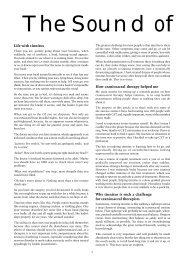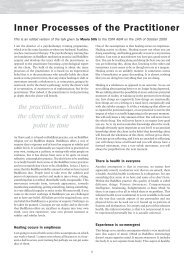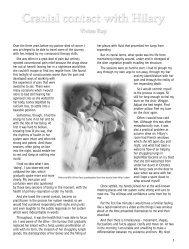Can craniosacral treatment improve the general well- being of ...
Can craniosacral treatment improve the general well- being of ...
Can craniosacral treatment improve the general well- being of ...
You also want an ePaper? Increase the reach of your titles
YUMPU automatically turns print PDFs into web optimized ePapers that Google loves.
It could be argued that <strong>the</strong> statistically inconclusive<br />
outcome may be due to <strong>the</strong> small sample size, from which<br />
it was not possible to detect a statistically significant<br />
difference (Warber et al 2003). In addition, <strong>the</strong>re were<br />
aspects <strong>of</strong> <strong>the</strong> experimental design that may have<br />
contributed to <strong>the</strong> apparent lack <strong>of</strong> evidence <strong>of</strong> <strong>the</strong><br />
efficacy <strong>of</strong> CST. For example, <strong>the</strong> controlled aspect <strong>of</strong> <strong>the</strong><br />
trial did not allow for <strong>the</strong> full assessment <strong>of</strong> needs in <strong>the</strong><br />
The proportion <strong>of</strong> patients who<br />
demonstrated an increase in <strong>the</strong>ir<br />
<strong>general</strong> <strong>well</strong>-<strong>being</strong> was 70%<br />
normal case history taking and with this information <strong>the</strong><br />
<strong>treatment</strong> <strong>of</strong> <strong>the</strong> individual. In addition, those subjects<br />
that did not demonstrate an <strong>improve</strong>ment may have done<br />
so if more than <strong>the</strong> two <strong>treatment</strong>s available in this trial<br />
had been provided.<br />
The trial used non-bodywork <strong>the</strong>rapists for <strong>the</strong><br />
simulated <strong>treatment</strong>s, to avoid any type <strong>of</strong><br />
<strong>the</strong>rapeutic/healing touch that may occur from an<br />
experienced bodyworker and that consequently would<br />
invalidate <strong>the</strong> desired simulated <strong>treatment</strong> (Horrigan<br />
1996). However, <strong>the</strong> trial could not exclude (or<br />
realistically measure) natural healing abilities <strong>of</strong> <strong>the</strong><br />
<strong>the</strong>rapists, which could have influenced <strong>the</strong> outcome. So,<br />
CRANIOSACRAL SEMINAR<br />
AT HOATHLY HILL WITH<br />
ERWIN VAN DE VELDE<br />
and Bee Meredith Hernandez<br />
Last <strong>of</strong> current series<br />
18 June 2006:The abdominal plexi<br />
The day will include <strong>the</strong>ory and practical work.<br />
Maximum <strong>of</strong> 16 participants.<br />
The venue is <strong>the</strong> hall at <strong>the</strong> Hoathly Hill community<br />
in rural Mid-Sussex<br />
about 30 miles south <strong>of</strong> London.<br />
Rail travel possible.<br />
Please send course fee <strong>of</strong> £50 or<br />
non-returnable deposit <strong>of</strong> £15 to:<br />
Roger James, 9 Ridleys,West Hoathly,<br />
East Grinstead,West Sussex, RH19 4HN<br />
Inquiries phone 01342 810112<br />
Courses valid for <strong>craniosacral</strong> <strong>the</strong>rapy training<br />
requirement for CSTA members<br />
it is not possible for this research to identify where any<br />
<strong>improve</strong>ments originated in <strong>the</strong> simulated <strong>treatment</strong>s: if<br />
due to a natural <strong>improve</strong>ment <strong>of</strong> <strong>the</strong> patient’s condition<br />
(Kienle & Kiene 2001); due to <strong>the</strong> placebo effect (Ernst<br />
2001); <strong>the</strong> simulated practitioner’s natural healing<br />
qualities (Crawford et al 2003); or a combination <strong>of</strong> all <strong>of</strong><br />
<strong>the</strong>m (Hubble et al 2004). In fact, it is impossible to<br />
estimate how much <strong>of</strong> <strong>the</strong>se effects were also part <strong>of</strong> <strong>the</strong><br />
test <strong>treatment</strong>s score (Ernst 1992). Additionally, <strong>the</strong><br />
research did not take into consideration any changes in<br />
<strong>the</strong> participants’ personal circumstances that might have<br />
occurred while <strong>the</strong>y were in <strong>the</strong> trial which could have<br />
affected <strong>the</strong>ir <strong>well</strong>-<strong>being</strong> scores at a critical stage <strong>of</strong> <strong>the</strong><br />
research and which might have affected <strong>the</strong> outcome.<br />
Patients’ hopes, mood, expectations, and state <strong>of</strong><br />
relaxation would also influence symptoms; it is important<br />
to collect baseline data on <strong>the</strong> subjects’ psychological<br />
state and <strong>the</strong>ir anticipation <strong>of</strong> benefits from <strong>the</strong> <strong>treatment</strong><br />
(Warber et al 2003). The subjects’ reasons for participating<br />
in <strong>the</strong> trial, and <strong>the</strong>ir beliefs and values would have also<br />
been needed. Three subjects caught a cold or flu near <strong>the</strong><br />
end <strong>of</strong> <strong>the</strong> trial. However, <strong>the</strong> fact that <strong>the</strong>se three<br />
subjects’ scores dramatically dropped in week four <strong>of</strong> <strong>the</strong><br />
trial followed by a rapid increase <strong>of</strong> <strong>the</strong> final score <strong>of</strong> <strong>the</strong><br />
questionnaire, showed <strong>the</strong> accuracy <strong>of</strong> <strong>the</strong> GWS in<br />
measuring changes in <strong>the</strong> patients’ <strong>well</strong>-<strong>being</strong>. Also, <strong>the</strong>se<br />
results could have been an indication <strong>of</strong> <strong>the</strong> subjects<br />
going through a healing crisis after <strong>the</strong> CST <strong>treatment</strong>.<br />
This could have happened due to <strong>the</strong> patients’ systems<br />
<strong>being</strong> overloaded and this may have been due to <strong>the</strong><br />
participants’ compromised immune system trying to find<br />
some space for healing to occur, meaning that sometimes<br />
<strong>the</strong> patient may get worse to get better (Kern 2001).<br />
In a future study, more precise criteria would be<br />
needed for <strong>the</strong> selection <strong>of</strong> subjects in order to ensure a<br />
<strong>well</strong>-defined group (Warber et al 2003). Although <strong>the</strong><br />
subjects’ presenting symptoms might have appeared good<br />
enough at first to be included in <strong>the</strong> trial, it now appears<br />
that insufficient investigation was undertaken to check<br />
whe<strong>the</strong>r subjects had sub-clinical conditions for which<br />
CST was not appropriate, and this would have been<br />
reflected in <strong>the</strong> questionnaire results (Kienle & Kiene<br />
2001). In addition, some subjects may have had a state <strong>of</strong><br />
<strong>well</strong>-<strong>being</strong> at <strong>the</strong> start <strong>of</strong> <strong>the</strong> study that was so high that it<br />
would be difficult to demonstrate an <strong>improve</strong>ment. For<br />
example one subject had a score in week one <strong>of</strong> 81,<br />
showing an initial positive <strong>well</strong>-<strong>being</strong> on <strong>the</strong> GWS score<br />
(McDo<strong>well</strong> & Ne<strong>well</strong> 1996) thus making her an<br />
unsuitable candidate for <strong>the</strong> research. O<strong>the</strong>r points that<br />
may have affected <strong>the</strong> outcome <strong>of</strong> <strong>the</strong> trial were: simulated<br />
<strong>the</strong>rapists’ positive intention when treating; carry-over<br />
effects from <strong>treatment</strong>s validating human caring and<br />
interaction as part <strong>of</strong> <strong>the</strong> <strong>the</strong>rapeutic response; patients<br />
wanting to do <strong>well</strong> (Hawthorne effect); underestimated<br />
severity <strong>of</strong> <strong>the</strong> patients’ presenting symptoms.<br />
8





